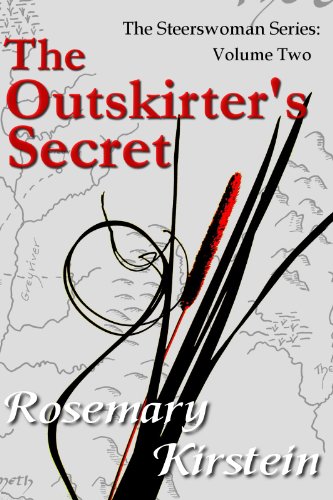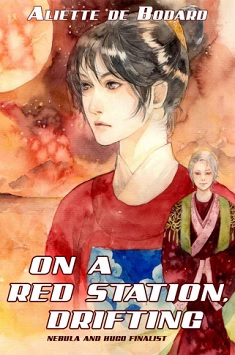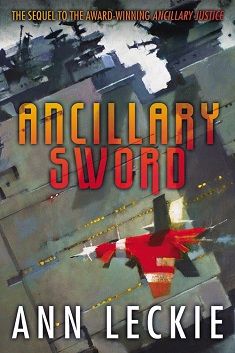
The Outskirter’s Secret
Rosemary Kirstein
342 pages
published in 1992
The Outskirter’s Secret is the sequel to The Steerswoman, the second in what’s so far a four book, projected to be seven book series. Kirstein is one of those authors who’ve fallen between the cracks of the science fiction/fantasy field: incredibly loved by those who’ve read her books, but barely known outside that circle of aficionados. The trouble is, for all sort of reasons, she isn’t a fast writer; the first two books in the series were written in 1989 and 1992, the second two in 2003 and 2004, with the fifth scheduled for publishing next year. Perhaps. Which means that, because she’s never been the runaway bestseller kind of author, that her books slip out of print faster than they’re written and you have to luck into finding her books secondhand to be initiated into her cult once you’ve heard people like Jo Walton rave about her. Luckily these days there are ebooks.
The Steerswoman series is science fiction in what looks like a fantasy setting, complete with wizards, dragons and goblins, in which Rowan, the titular steerswoman through her curiosity and intelligence is driven to investigate the nature of her world. Steerswomen (as well as the occasional steerman) are members of what you may call a semi religious order bound to answer any question truthfully as long as in return their own questions are also answered in the same manner. In the first book, Rowan’s curiosity into a peculiar kind of worked blue stone she found made her into a target for a wizard conspiracy. She escaped and in The Outskirter’s Secret, together with her faithful companion Bel, an Outskirter herself, a member of one of the nomadic tribes living in the wildernesses beyond the civilised inner lands, sets out to track down the source of the blue stones, deep in the Outskirts.
The Outskirter’s Secret starts out as a quest story, as Rowan and Bel move out from the familiar Inner Lands into the Outskirts, looking for a tribe to join for the duration, as they wouldn’t be able to survive on their own. It’s a reversal of the first book, where Bel was the one asking questions of Rowan about Inner Lands customs, now it’s Rowan who has to be guided around the dangers of the Outskirts, which are many. This is of course a well known fantasy plot type, the quest out into the untamed wilderness beyond civilisation to find a source of great power and much of what Rowan and Bel encounter could be read in fantasy terms.
So for example a goblin attack leads them to rescue a member of one Outskirter tribe, which gets them accepted into the tribe. The tribe itself is also familiar from countless fantasy stories (and further back, the western pulp stories these were “inspired” by). You got your young warriors and scouts, the usaul honour code and the core of elder men and women providing everything else. The tribe follows its goat herds across the great grassy plains, eking out an existence, moving on once the herd has devestated the landscape, with the goats providing everything the tribe eats. Only here the grass is red.
But this isn’t a fantasy story and the Outskirters aren’t badly thought out fantasy analogues of real world nomadic tribes. This is science fiction, perhaps one of the purest science fiction novels I’ve ever read. The heart of The Outskirter’s Secret isn’t the quest for the downed guidestar, it’s the slow revelation of the true relationship of the Outskirters to their environment as Rowan first wonders at how different their life is from the Inner Lands and then starts to figure out why that is.
The Outskirter’s Secret is a classic science fiction puzzle story, where the reader already knows the big secret of Rowan and Bel’s world and the pleasure lies in seeing the pieces fall in place. This only works if it’s done honestly, if there aren’t any convenient infodumps brought by mysterious strangers clueing in the protagonist to the real nature of her world, if Rowan doesn’t come to conclusions we know are true but she couldn’t possibly have known. As readers we knew or suspected that Rowan’s world is being terraformed and that this explains the dual nature of the Inner Lands and the Outskirts, but Rowan can’t know that, as that’s completely outside her frame of reference.
In The Steerswoman, Kirstein already proved that she could have Rowan come to the right conclusions honestly, when she had her calculate where the blue jewels that actually set her off on her quest came from, based on the spread of where they had been found, “as if a giant had flung them”. That ultimately led her to the conclusion that the source of these stones was actually a hithero unsuspected guidestar that had come down from its orbit, which led her and Bel into the Outskirts in search of it. Which in turn leads her to discover the differences between Outskirter life and that of the Inner Lands.
That process of discovery Rowan engages in alongside the more conventional quest plot is what makes The Outskirter’s Secret one of the great ecological science fiction novels. Through Rowan’s deductions, based on Bel and other Outskirters’ explanations of life in the Outskirts, it becomes clear that it is a border zone between the terrestrial ecology of the Inner Lands and the actual alien ecologies lying beyond the Outskirts. It also becomes clear, early in the novel even, that the Inner Lands and the Outskirts are not static, but that as the former grow, the latter move outwards. This explains the nomadic Outskirter lifestyle, completely dependent on their goat herds for substance. The presence of these herds and the Outskirters themselves as they actively hunt down and destroy Outskirter life, destroys the landscape they move through, requiring them to keep moving.
Behind all of this there’s the overall metaplot that got started in The Steerswoman, the central mystery of the wizards and Slado, their leader and what he’s up to. We get another piece of that puzzle here in the form of the discoveries Rowan makes about the relationship between Inner Lands and the Outerskirts, but much is still unclear. There’s also still the problem of the fallen guidestar and what made it fall.
Two other things that struck me about The Outskirter’s Secret and this series in general is the friendship between Rowan and Bel, one of the best portrayed friendships in science fiction, as well as the general agency and equality of women in this series. There’s no hint of the pseudo equality of so many fantasy series that put men and women in traditionalist, medievaloid gender roles with some handwaving about the power of the village women council or some invented pseudoreligious magical order. Instead, men and women do the same work and have the same responsibilities in Outskirter society, without Kirstein making a big production out of this. It’s just the way the world works.
The other thing that struck me is how much of a comfort read this was for me, even though I’ve never read this series before. From the first scene Kirstein had me at ease, willing to spent as much time in her world as she allowed. It’s rare to have a book so welcoming and with so much to say as well. It’s what makes this book, this series, so special.



